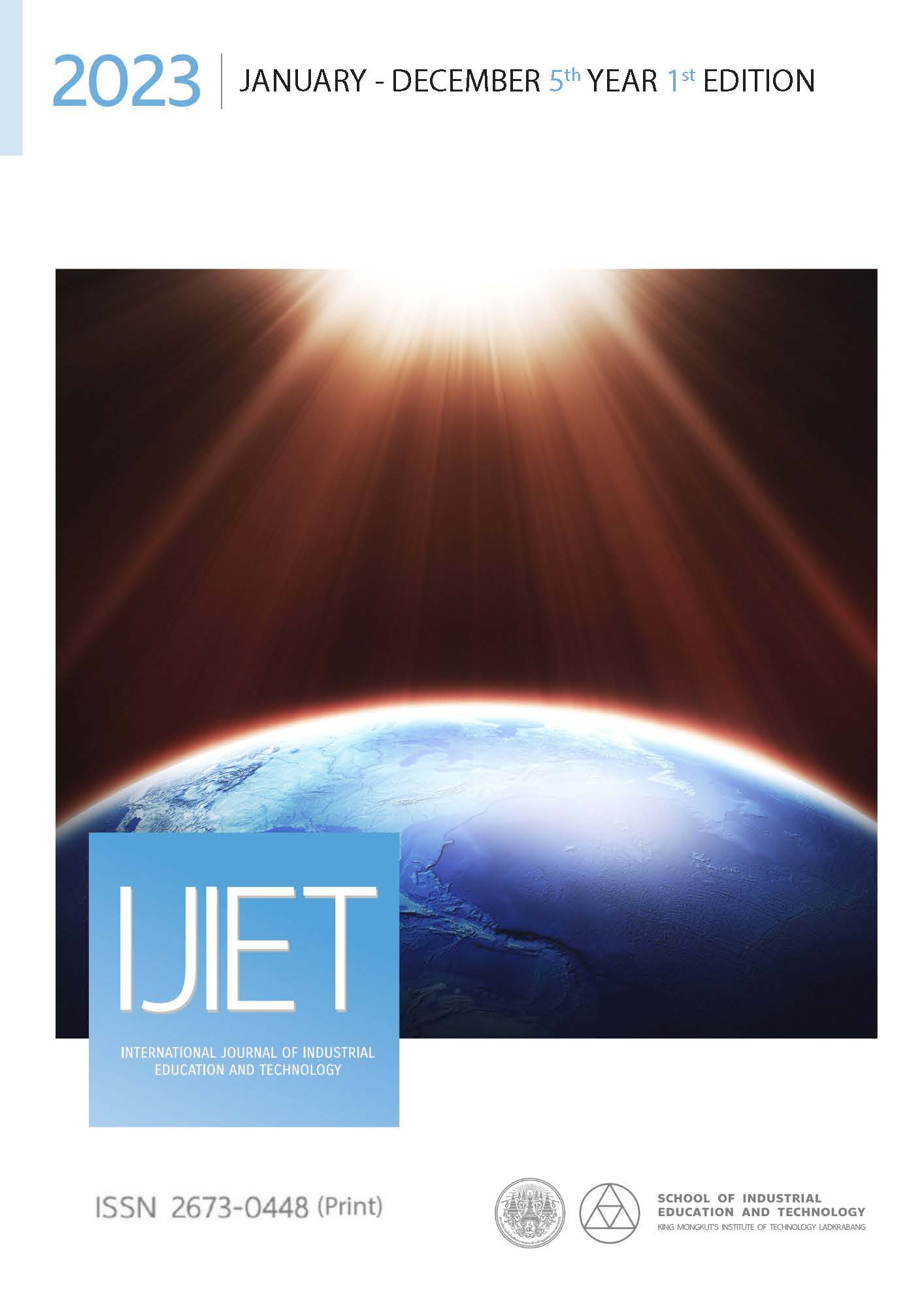COMPARISON OF SEVERE GEOMAGNETIC STORM EVENT AND LOW-LATITUDE TOTAL ELECTRON CONTENT ANOMALIES
Keywords:
Geomagnetic storm, GPS TEC, Low-latitude, Total electron contentAbstract
In this study, we examined the Total Electron Content (TEC) anomalies at different scales during geomagnetic storms using Global Positioning System (GPS) satellites at low latitudes, which contributed to the catastrophic geomagnetic storm that occurred on March 24th, 2023. SIET KMITL, Bangkok station (13.729°N, 100.780°E) and KMITL Chumphon station (10.724°N, 99.375°E), Thailand, are the low-latitude GPS stations. After comparing the two GPS TEC stations, we examined the connection between TEC anomalies in the ionosphere and geomagnetic storm sizes. The findings demonstrate that ionosphere anomalies detected by GPS TEC correlate with geomagnetic storm timing. The findings demonstrate that ionospheric TEC anomalies detected by GPS were noticed that the GPS TEC values at both stations increase in proportion to the strength of the geomagnetic storm on days when the storm's intensity is higher. TEC levels rise progressively during periods of high geomagnetic storm severity. Even after the storm passes, TEC stays raised for two to three days before gradually falling back to normal. The maximum value of TEC, about 35 TECU, was observed at the SIET KMITL, Bangkok station (13.729°N, 100.780°E), whereas TEC increased to about 25 TECU at the KMITL Chumphon station (10.724°N, 99.375°E). TEC is high and positively correlated with an increase in days with intense geomagnetic storms. A rise in the frequency of intense geomagnetic storms is positively connected with TEC. However, in typical circumstances, TECs do not decrease in a negative direction during the quiet period.
References
Blewitt, G. (1990). An automatic editing algorithm for GPS data. Geophysical Research Letters, 17(3), 199-202.
Bojilova, R., & Mukhtarov, P. (2023). Comparative analysis of global and regional ionospheric responses during two geomagnetic storms on 3 and 4 February 2022. Remote Sensing, 15(7), 1-23.
Chen, Z., Wang, J. S., Deng, Y., & Huang, C. M. (2017). Extraction of the geomagnetic activity effect from TEC data: A comparison between the spectral whitening method and 28 day running median. Journal of Geophysical Research: Space Physics, 122(3), 3632-3639.
Chernyshov, A. A., Miloch, W. J., Jin, Y., & Zakharov, V. I. (2020). Relationship between TEC jumps and auroral substorm in the high-latitude ionosphere. Scientific Reports, 10(6363), 1-13.
Nayak, C., Tsai, L. C., Su, S. Y., Galkin, I. A., Tan, A. T. K., Nofri, E., & Jamjareegulgarn, P. (2016). Peculiar features of the low-latitude and midlatitude ionospheric response to the St. Patrick's Day geomagnetic storm of 17 March 2015. Journal of Geophysical Research: Space Physics, 121(8), 7941-7960.
de Paula, E. R., de Oliveira, C. B. A., Caton, R. G., Negreti, P. M., Batista, I. S., Martinon, A. R. F., Neto, A. C., Abdu, M. A., Monico, J. F. G., Sousasantos, J., & Moraes, A. O. (2019). Ionospheric irregularity behavior during the September 6-10, 2017 magnetic storm over Brazilian equatorial–low latitudes. Earth, Planets and Space, 71(42), 1-15.
Dugassa, T., Habarulema, J. B., & Nigussie, M. (2019). Investigation of the relationship between the spatial gradient of total electron content (TEC) between two nearby stations and the occurrence of ionospheric irregularities. Annales Geophysicae, 37(6), 1161-1180.
Goodwin, G. L., Silby, J. H., Lynn, K. J. W., Breed, A. M., & Essex, E. A. (1995). GPS satellite measurements: ionospheric slab thickness and total electron content. Journal of Atmospheric and Terrestrial Physics, 57(14), 1723-1732.
Kenpankho, P., Watthanasangmechai, K., Supnithi, P., Tsugawa, T., & Maruyama, T. (2011). Comparison of GPS TEC measurements with IRI TEC prediction at the equatorial latitude station, Chumphon, Thailand. Earth, Planets and Space, 63, 365-370.
Klimenko, M. V., Klimenko, V. V., Zakharenkova, I. E., Ratovsky, K. G., Korenkova, N. A., Yasyukevich, Y. V., Mylnikova, A. A., & Cherniak, I. V. (2017). Similarity and differences in morphology and mechanisms of the foF2 and TEC disturbances during the geomagnetic storms on 26-30 September 2011. Annales Geophysicae, 35(4), 923-938.
Li, G., Ning, B., Zhao, X., Sun, W., Hu, L., Xie, H., Liu, K., & Ajith, K. K. (2019). Low latitude ionospheric TEC oscillations associated with periodic changes in IMF Bz polarity. Geophysical Research Letters, 46(16), 9379-9387.
Ma, G., & Maruyama, T. (2003). Derivation of TEC and estimation of instrumental biases from GEONET in Japan. Annales Geophysicae, 21(10), 2083-2093.
Mukaka, M. M. (2012). Statistics corner: A guide to appropriate use of correlation coefficient in medical research. Malawi Medical Journal, 24(3), 69-71.
Nava, B., Rodríguez-Zuluaga, J., Alazo-Cuartas, K., Kashcheyev, A., Migoya-Orué, Y., Radicella, S. M., Amory-Mazaudier, C., & Fleury, R. (2016). Middle- and low-latitude ionosphere response to 2015 St. Patrick's Day geomagnetic storm. Journal of Geophysical Research: Space Physics, 121, 3421-3438.
Rao, S. S., Galav, P., Sharma, S., & Pandey, R. (2013). Low-latitude TEC variability studied from magnetically conjugate locations along 73° E longitude. Journal of Atmospheric and Solar-Terrestrial Physics, 104, 1-6.
Ratovsky, K. G., Klimenko, M. V., Dmitriev, A. V., & Medvedeva, I. V. (2022). Relation of extreme ionospheric events with geomagnetic and meteorological activity. Atmosphere, 13, 1-15.
Reddybattula, K. D., Panda, S. K., Ansari, K., & Peddi, V. S. R. (2019). Analysis of ionospheric TEC from GPS, GIM and global ionosphere models during moderate, strong, and extreme geomagnetic storms over Indian region. Acta Astronautica, 161, 283-292.
Serafimov, K. B., Arshinkov, I. S., Bochev, A. Z., Petrunova, M. H., Stanev, G. A., & Chapkanov, S. K. (1982). A measuring equipment for electric and magnetic fields in the range of the ionosphere-Magnetosphere plasma mounted aboard the “Intercosmos-Bulgaria 1300” satellite. Acta Astronautica, 9(6-7), 397-399.
Downloads
Published
Issue
Section
License
Copyright (c) 2023 International Journal of Industrial Education and Technology

This work is licensed under a Creative Commons Attribution-NonCommercial-NoDerivatives 4.0 International License.



